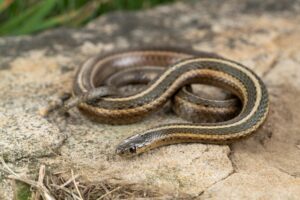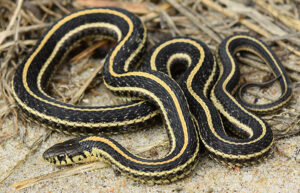Where Do Garter Snakes Live? Garter snakes, with their distinctive patterning and docile nature, are among the most common reptiles found across North America. From sprawling suburban gardens to dense forest floors, these adaptable serpents carve out habitats in a diverse range of environments.
Garter snakes are widely distributed across North America, ranging from southern Canada down to Central America. They are found in a variety of habitats, including forests, grasslands, meadows, marshes, and even urban areas such as parks and gardens.
These versatile snakes are known for their ability to adapt to different environments, making them one of the most common snake species in many regions.
What are Garter Snakes?

Garter snakes are a common type of non-venomous snake found throughout North America. They belong to the genus Thamnophis, which includes numerous species and subspecies. Garter snakes are known for their slender bodies, typically striped or patterned in various colors, such as green, brown, black, or red.
These snakes are adaptable and can be found in a variety of habitats, including forests, meadows, marshes, and even urban areas. They are often seen near water sources like ponds, streams, and gardens, as they feed on small amphibians, fish, insects, and sometimes small mammals.
Garter snakes are not harmful to humans and are often kept as pets due to their docile nature and ease of care. They play an important role in controlling pest populations and are generally considered beneficial to have around.
What is the natural habitat of garter snakes?
Garter snakes inhabit a wide range of habitats across North America, including:
- Woodlands: Garter snakes can be found in deciduous forests, coniferous forests, and mixed woodlands. They often take shelter under logs, rocks, and leaf litter.
- Grasslands: Garter snakes thrive in open grasslands, prairies, and meadows where they can find ample prey and suitable places for basking and hibernating.
- Wetlands: They are commonly found in marshes, swamps, and along the edges of ponds, lakes, and streams. These areas provide access to water as well as a diverse range of prey items.
- Riparian Areas: Garter snakes are frequently spotted near rivers, creeks, and other riparian zones, where they can hunt for aquatic prey and utilize the diverse vegetation for shelter.
- Urban and Suburban Areas: Some species of garter snakes have adapted to human-modified environments, such as parks, gardens, and residential areas, where they may feed on insects and rodents.
Overall, garter snakes are highly adaptable and can thrive in a variety of habitats, as long as they can find suitable shelter, food, and access to water. They are often encountered in areas with a combination of vegetation, moisture, and abundant prey.
Where can you find garter snakes?
Garter snakes, scientifically known as Thamnophis sirtalis, are widespread throughout North America, ranging from Canada to Central America. They are highly adaptable and can thrive in a variety of habitats, including forests, grasslands, meadows, marshes, wetlands, and even urban areas.
Here’s a breakdown of where you might find them:
- Grasslands and meadows: Garter snakes are often found in open grassy areas where they can easily hunt for their preferred prey, such as insects, earthworms, and small amphibians.
- Forests: While not as common as in open habitats, garter snakes can still be found in forested areas, particularly along forest edges where there is a mix of open space and vegetation cover.
- Wetlands and marshes: Garter snakes are frequently found near water sources such as ponds, streams, and marshes. These areas provide both a water source and a habitat for the frogs, fish, and other prey that garter snakes feed on.
- Urban and suburban areas: Garter snakes are surprisingly adaptable to human environments and can often be found in gardens, parks, and other green spaces within cities and suburbs. They may take shelter under rocks, logs, or debris and hunt for prey like mice and insects in these areas.
Overall, garter snakes are generalist species, meaning they can survive and thrive in a wide range of habitats as long as they have access to food, water, and suitable places to hide and hibernate.
What do garter snakes need in their habitat to survive?

Garter snakes, like all organisms, have specific habitat requirements to survive and thrive. Here are some key elements:
- Shelter: Garter snakes need places to hide and rest, especially during the hottest parts of the day and during colder periods. They seek shelter under rocks, logs, vegetation, and in underground burrows.
- Food: Garter snakes are carnivorous and primarily feed on small prey such as insects, earthworms, frogs, small rodents, and fish. Their habitat needs to support a sufficient population of prey species to sustain them.
- Water: While garter snakes don’t need to live directly in water, they typically inhabit areas near water sources such as streams, ponds, marshes, or other wetlands. Access to water is important for drinking and sometimes for hunting.
- Temperature regulation: Garter snakes are ectothermic, meaning they rely on external sources of heat to regulate their body temperature. Therefore, their habitat needs to provide a range of microclimates where they can bask in the sun to warm up or seek shade to cool down as needed.
- Cover and habitat diversity: Garter snakes prefer habitats with a mix of open spaces and vegetation cover. This diversity provides opportunities for hunting, hiding, and basking, as well as protection from predators.
- Hibernation sites: Garter snakes hibernate during the winter in communal dens known as hibernacula. These sites are typically located underground or in rock crevices where temperatures remain above freezing. Suitable hibernation sites are crucial for their survival during the colder months.
Overall, a healthy garter snake habitat provides a balance of food, shelter, water, and suitable environmental conditions for their life cycle, including breeding, foraging, and hibernation. Conservation efforts often focus on preserving and restoring these essential elements in garter snake habitats to ensure their survival.
How do garter snakes interact with their habitat?
Garter snakes are highly interactive with their habitat, exhibiting a range of behaviors and adaptations that allow them to thrive in diverse environments. Here’s how they interact with their habitat:
- Foraging: Garter snakes are active hunters, constantly on the lookout for prey such as insects, earthworms, frogs, and small rodents. They use their keen sense of smell and sight to locate potential meals in their environment.
- Basking: Like other reptiles, garter snakes are ectothermic, meaning they rely on external sources of heat to regulate their body temperature. They often bask in the sun on rocks, logs, or other warm surfaces to raise their body temperature and increase their metabolic rate.
- Sheltering: Garter snakes require hiding places for protection from predators and extreme weather conditions. They seek shelter under rocks, logs, vegetation, and in underground burrows, utilizing various microhabitats within their environment.
- Reproduction: Garter snakes engage in courtship rituals and mate during the spring months. Females seek out suitable nesting sites in the form of warm, secluded locations where they can deposit their eggs. These nesting sites are an important aspect of their habitat interaction during the breeding season.
- Migration: Some populations of garter snakes undertake seasonal migrations between different habitats, often in search of food, breeding sites, or suitable hibernation locations. These migrations can span significant distances and are essential for their survival and reproductive success.
- Hibernation: During the winter months, garter snakes hibernate in communal dens known as hibernacula. These dens provide a stable microclimate where temperatures remain above freezing, allowing the snakes to survive until spring. Finding and utilizing suitable hibernation sites is a critical aspect of their habitat interaction.
- Prey-predator dynamics: Garter snakes play a role in controlling populations of their prey species, helping to maintain ecological balance within their habitat. At the same time, they themselves are preyed upon by various predators such as birds of prey, mammals, and other snakes, contributing to the complex web of interactions in their ecosystem.
Overall, garter snakes are intimately connected to their habitat, actively interacting with it in various ways to meet their needs for food, shelter, reproduction, and survival throughout the different seasons of the year.

How individuals can help protect garter snake habitats
Individuals can play a crucial role in protecting garter snake habitats through various actions and advocacy efforts. Here are some ways to help:
- Support habitat conservation: Get involved with local conservation organizations or initiatives focused on preserving and restoring natural habitats where garter snakes live. Support policies and practices that prioritize habitat protection and restoration.
- Reduce habitat destruction: Advocate for responsible land use practices that minimize habitat destruction and fragmentation, such as sustainable development, land-use planning, and conservation easements. Avoid contributing to habitat loss through activities like deforestation, urban sprawl, and wetland drainage.
- Create habitat features: Enhance garter snake habitat by creating features such as rock piles, log piles, brush piles, and native plant gardens in your yard or community green spaces. These features provide shelter, basking spots, and foraging opportunities for garter snakes and other wildlife.
- Promote biodiversity: Plant native vegetation in your yard or community to support a diverse range of plant and animal species, including those that garter snakes depend on for food and shelter. Avoid using pesticides and herbicides that can harm snakes and their prey.
- Minimize disturbances: Be mindful of your activities when visiting natural areas where garter snakes live. Stay on designated trails, keep pets leashed, and avoid disturbing snakes or their habitat, especially during sensitive times such as the breeding season or hibernation.
- Report sightings: Participate in citizen science initiatives by reporting garter snake sightings to local wildlife agencies or conservation organizations. Your observations can help researchers track population trends, identify important habitat areas, and inform conservation efforts.
- Educate others: Raise awareness about the importance of garter snakes and their habitats among your friends, family, and community. Share information about their ecological role, habitat needs, and conservation challenges, and encourage others to take action to protect them.
By taking these steps, individuals can contribute to the conservation of garter snake habitats and help ensure the long-term survival of these fascinating and ecologically important creatures.
Conclusion
Garter snakes, adaptable and widespread, inhabit a variety of environments across North America. Where Do Garter Snakes Live? From grasslands and forests to wetlands and urban areas, these resilient reptiles carve out niches wherever suitable conditions exist.
Their interactions with these habitats, from foraging and basking to seeking shelter and reproducing, underscore their vital role in their ecosystems. Protecting garter snake habitats through conservation efforts, responsible land use practices, and individual actions ensures the continued existence of these fascinating creatures in the wild.

